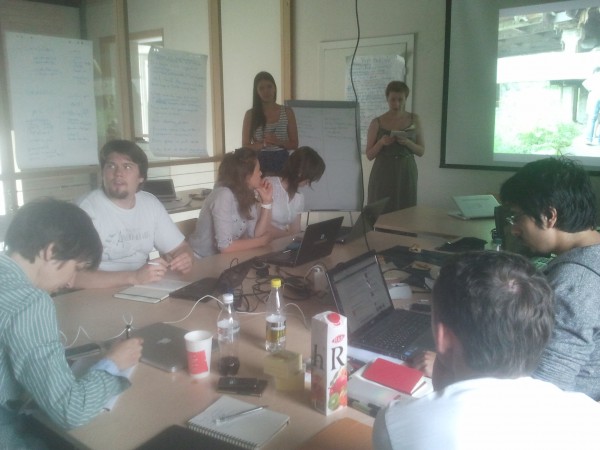On the third day of the workshop ’Designing for Ownership’ we proceeded with problem analysis and generation of ideas for the area. Teams prepared and presented their SWOT analysis of the most important issues in that neighborhood, and identified stakeholders, important locations, and media channels in use. Here’s the analysis of both the green team and grey team:
We decided to inverse our analysis of the underlying issues and the ideation phase, by starting with generating as many ideas as possible for the neighborhood, and then extracting an iterative analysis of the most important issues from these ideas. We figured that the (re)formulation of complex issues would naturally emerge from this creative thinking, instead of narrowing the bandwidth for ideation too much in advance by beginning with the analysis. That worked really well.
We identified five possible complex issues in Yuzhnoye Medvedkovo that should be addressed (see below). After that we wrapped up this very productive day by forming teams around these issues, and discussing what type of event would like to do on Saturday 14 July, the final day of the workshop.

Analysis of Problem
1. Phenomenon: lack of communication
Nothing is done when people complain about something.
Public bulletin boards are mostly official information by municipality; citizens cannot really contribute anything.
Analysis:
Lack of communication between actors.
Lack of feedback system: what is done with my complaint? (bureaucracy)
No room for own initiative, and no reward or incentive.
There are few venues for contributing your own ideas.
Possible solution:
Allow people to make something collectively in their neighborhood (‘commemorative objects’), e.g. a mural painting, a garden,
Allow people to contribute ideas via some medium and pinpoint ideas on a map.
Build a new pavilion where people can meet.
Reuse existing buildings, like libraries.
2. Phenomenon: vandalism
Vandalism of everything physical.
Analysis:
Lack of sense of ownership among people for environment.
Lack of responsibility of stakeholders.
Lack of regulation and consequent rapid action (of municipality).
Possible solution:
Make really solid stuff (but not so interesting)
‘Broken windows’: rapid repair.
Make people feel responsible (how..?)
Make park a living being by allowing it ‘to speak’ through data streams.
Have people (activists) act to solve problems themselves: stimulate DIY culture.
Moveable furniture ; deposit (small rent) system for furniture; “chair share”
3. Phenomenon: lack of infrastructure
There too little benches, trash bins, toilets, but also for social interaction between different people.
There is not much to do.
Analysis:
There is little in terms of (useful, interesting) objects, places or services for people to gather and make conversation.
People have little that they share with each other, like cultural events or media
Possible solution:
Organize an event to gather people and make them discuss issues they find important.
Periodical events in amphitheater, show propaganda films about doing good and collaboration.
Brand the neighborhood: “Rent-A-Tram”; “I Love Yuzhnoye Medvedkova” on bags from the local factory.
4. Phenomenon: policies represent people unequally
Almost all policy is directed towards children, old people, handicapped people, veterans, but not adults.
There is only one beer bar in the neighborhood.
Analysis:
Municipalities try to avoid touchy subjects and instead focuses on neutral topics.
Possible solution:
Create more bars and other places for adult (male) communality in the neighborhood; inclusive.
Have people themselves program spaces, e.g. dancing spaces, wedding space, morning sports.
Build parkour courses for teenagers on roofs.
Pop-up cafés in residential areas; run by local people.
Banya, sauna, etc.
5. Phenomenon: lack of participation
People seem to only want to do something for money, not out of free will.
Analysis:
There should be more cool activities to undertake, more room for entrepreneurship.
Possible solution:
Curate events together.
Some motivation or reward system for people who are active. Maybe through an area competition. ‘Citizen of the month’.
Signage with instructions for cleaning up (dog poo).
A kind of reciprocal non-monetary exchange circles between stakeholders, e.g. music school performing for veterans, who take care of security; or dog owners who meet with disabled people.









